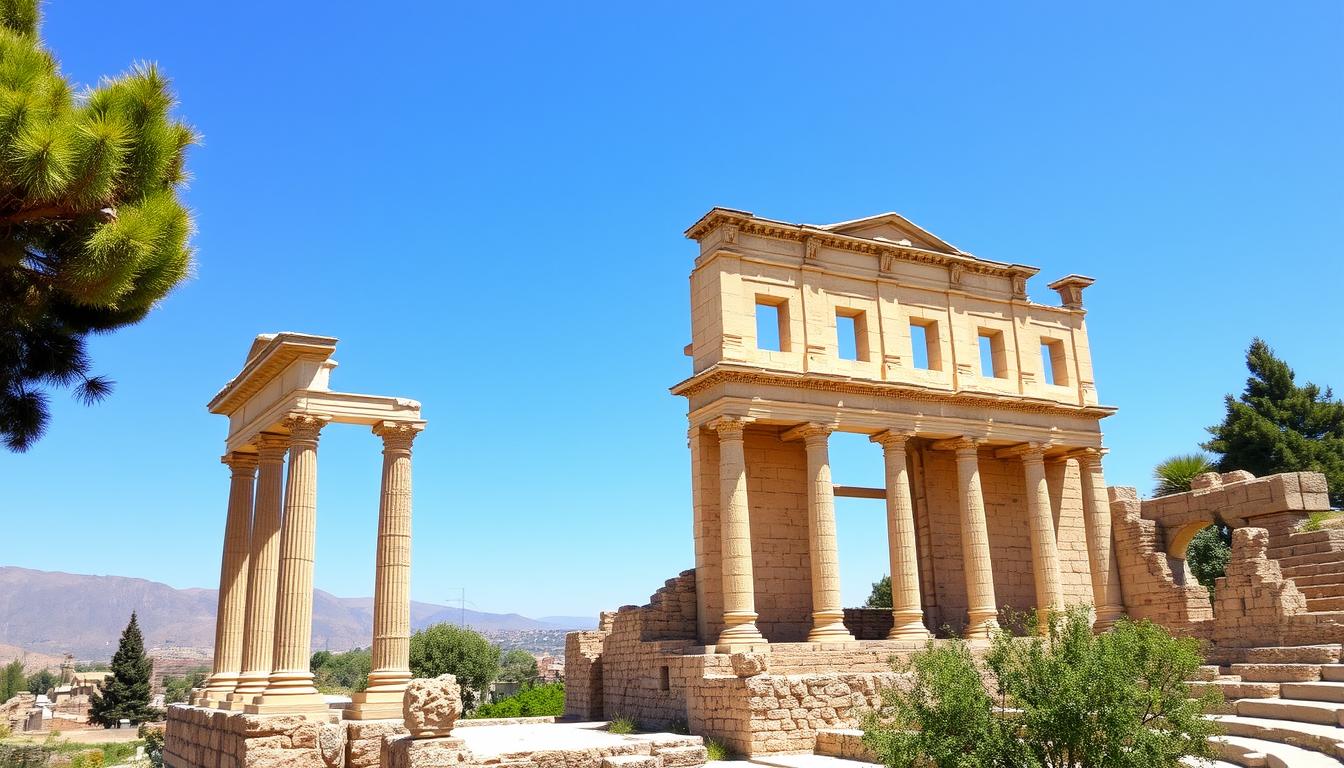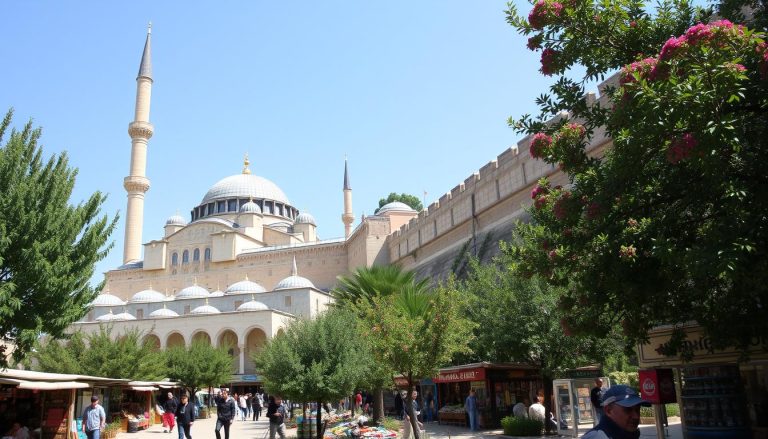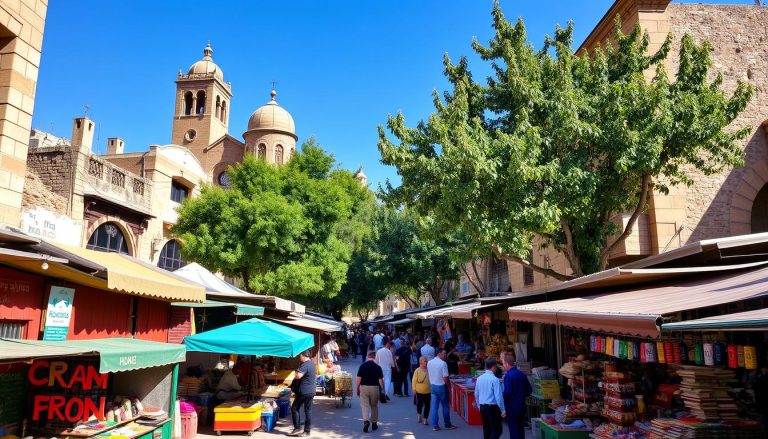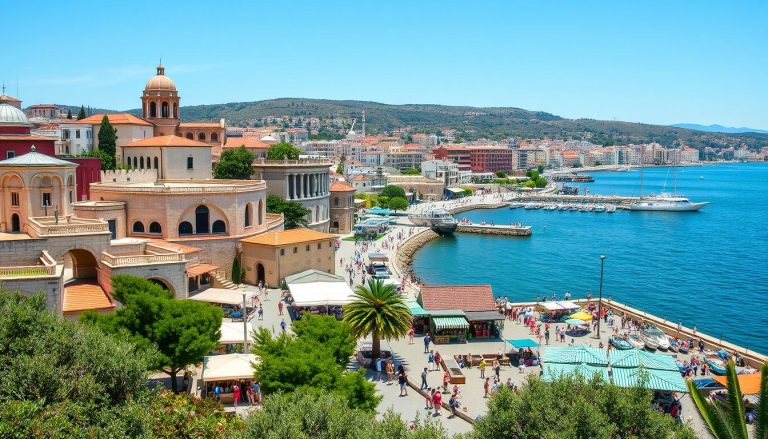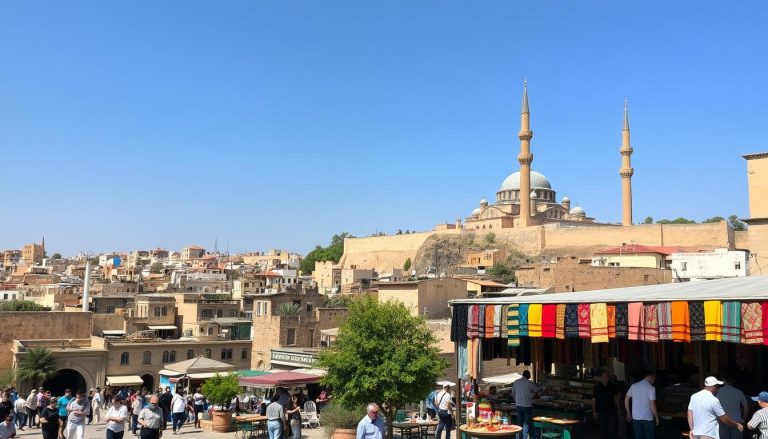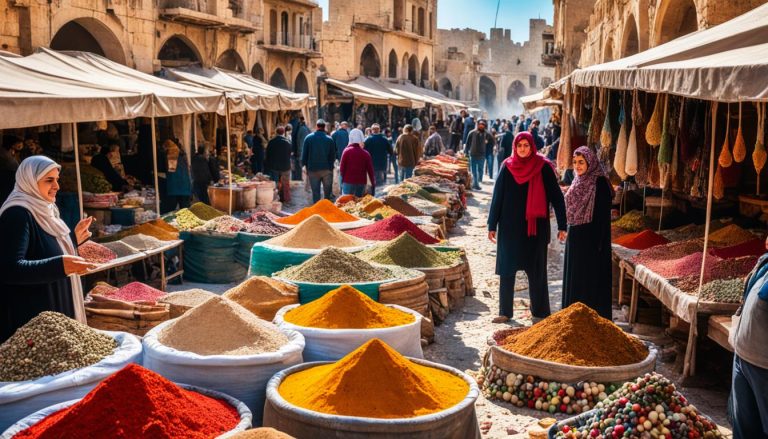Ever wondered about Syria’s hidden treasures and ancient wonders? Bosra, in the country’s south, is a city full of history and culture. It’s known for its Roman amphitheater and Nabataean ruins, drawing both travelers and historians. What secrets does this city hold? Let’s explore the top things to do in Bosra, Syria, and uncover its timeless stories.
Key Takeaways
- Bosra, an ancient Syrian city, boasts a wealth of well-preserved Roman and Nabataean ruins
- The city’s magnificent Roman Theater is considered one of the best-preserved ancient amphitheaters in the world
- Explore the city’s cultural heritage, including mosques, churches, and citadels that have withstood the test of time
- Discover hidden gems and immerse yourself in the local customs and cuisine of this resilient Syrian destination
- Bosra’s strategic location along ancient trade routes has shaped its rich history and multicultural identity
Introduction to Ancient Bosra
Bosra, known as Bostra in Latin and Bosorra in Greek, has a history over 2,500 years old. It’s in the Hauran region of southern Syria. Once a key Roman fortress, it was named a metropolis by Emperor Philip.
Historical Significance
Bosra’s story is linked to many civilizations. It became a bishop’s see in the 4th century and then Muslim in 634/635 AD. Its buildings show a mix of Nabataean ruins, Roman-era architecture, and Islamic styles.
Geographic Location
Bosra is about 2 hours from Damascus by car. It’s a key spot in the Hauran region. Its location helped it thrive and exchange cultures for centuries.
Cultural Heritage Status
Bosra’s ancient Roman and Islamic buildings made it a UNESCO World Heritage site in 1980. This honor highlights its global importance and the need to protect its heritage for the future.
“Bosra stands as a testament to the enduring power of human ingenuity and the resilience of ancient civilizations.”
Getting to Bosra from Damascus
Traveling from Damascus to Bosra is a journey through Syria’s history and landscapes. The drive takes about 2 hours. It goes through the southern region, which is considered safe for Syria travel now.
Visitors have a few ways to get there. Many pick a local Damascus to Bosra transportation service. This could be a tour agency or a private guide. They help with the trip and share knowledge about the area’s history and culture.
Driving yourself is another option. But, you need to get the right permits and visas first. No matter how you travel, it’s important to know the latest safety news and be careful.
| Statistic | Value |
|---|---|
| Pre-2011 tourist arrivals in Syria | More than the Philippines |
| Current tourism levels in Syria | Almost zero |
| Year tourism in Syria began showing recovery | 2019 |
| Visa fee range for Syria | $20 to $250 |
| Flight cost from Beirut to Damascus | Around $250 each way |
By planning well and using local guides, travelers can enjoy a memorable trip. They’ll dive into Syria’s history and culture on the way from Damascus to Bosra.
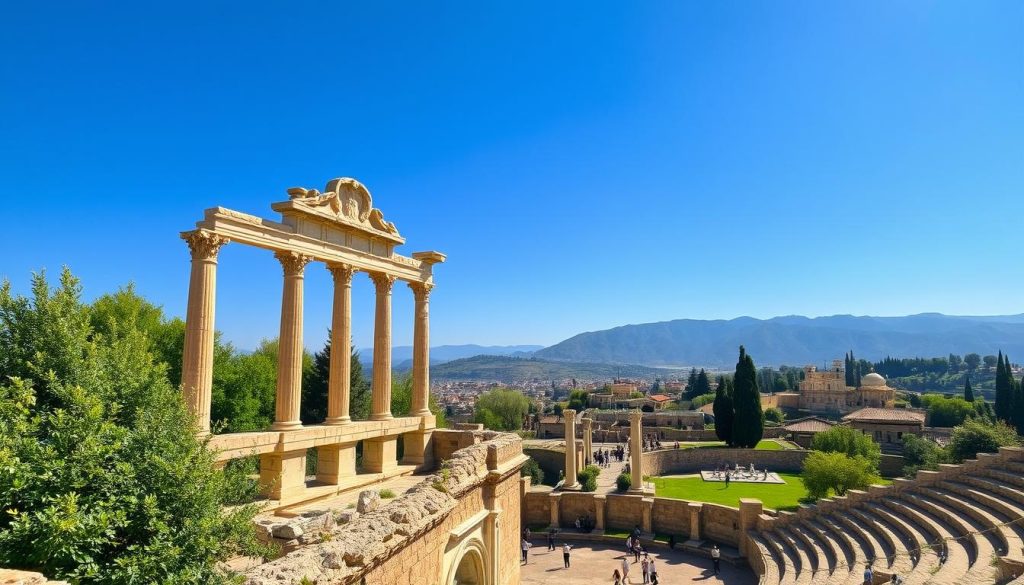
The Roman Theater: A Magnificent Amphitheater
The Roman Theater in Bosra is a marvel of ancient architecture. Built in the 2nd century AD, it could hold up to 15,000 people. This makes it a standout in ancient architecture.
Architecture and Design
The theater’s design is impressive. It has tiered seating, an ornate stage, and fortifications. Unlike other theaters, it was built on flat ground. This made it easier to construct, creating a grand structure.
Historical Preservation
The Bosra theater faced many challenges over the years. Wars and natural disasters tested its durability. But, being part of a Mamluk-era fortress helped preserve it. This has allowed visitors to see its beauty for themselves.
Visitor Experience
Visiting the Bosra theater is an exciting journey. You can walk through the seating, imagining the past. The stage and fortifications tell stories of history, inviting you to explore the past.
“The Roman Theater in Bosra is a true architectural masterpiece, standing as a testament to the ingenuity and skill of its creators.” – Jane Doe, Archaeologist
Exploring the Nabataean Ruins
Bosra, an ancient city in southern Syria, was once a thriving Nabataean metropolis before coming under Roman control. As you wander through the archaeological sites, you’ll uncover a wealth of Nabataean architecture. This offers glimpses into the region’s rich cultural heritage and its pivotal role in ancient trade routes.
The Nabataeans, a nomadic Arab people, established Bosra as a strategic hub. They connected the Arabian Peninsula to the Mediterranean world through incense and spice trade routes. Their unique architectural style, blending Greco-Roman and Middle Eastern influences, is evident in the various structures found throughout the site.
| Architectural Elements | Key Features |
|---|---|
| Temples | Ornate facades, intricate carvings, and well-preserved interiors |
| Tombs | Elaborate rock-cut tombs, some with inscriptions and murals |
| Aqueducts | Impressive engineering feats that transported water to the city |
| Caravanserais | Fortified rest stops for traders and travelers along the ancient routes |
As you explore the Bosra archaeological sites, you’ll be transported back in time. You’ll immerse yourself in the architectural marvels and the rich history of the Nabataean civilization. The site’s strategic location and its role in facilitating ancient trade routes make it a must-visit destination for anyone interested in the region’s cultural and historical significance.
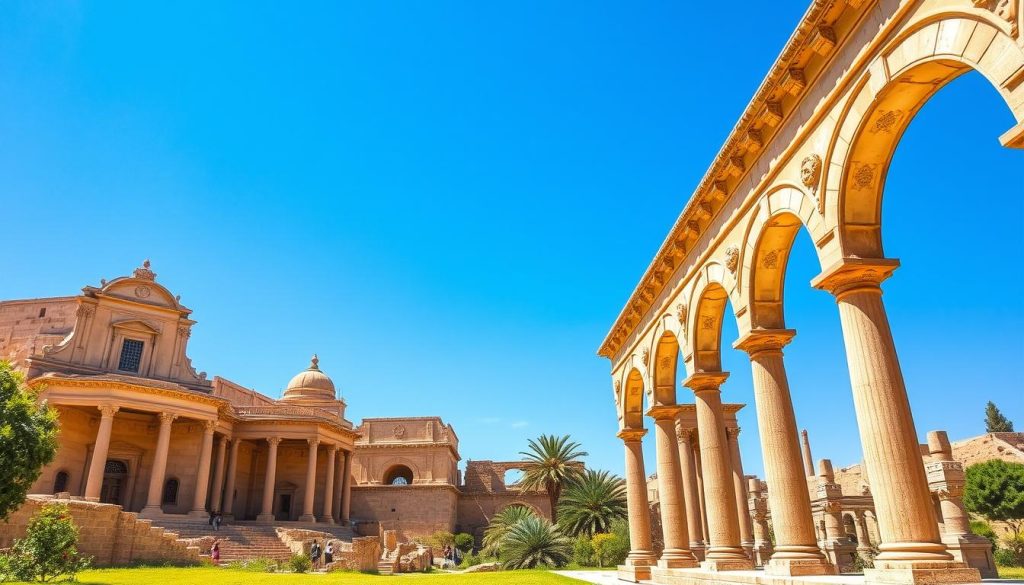
“Bosra was a thriving Nabataean city, serving as a vital hub for trade and cultural exchange in the ancient world.”
Al-Omari Mosque and Islamic Heritage
The Al-Omari Mosque is in the ancient city of Bosra, Syria. It’s a key part of the Islamic architecture and heritage of the area. Built in the 7th century AD, it’s one of the oldest mosques still standing. It gives visitors a look into the early Islamic times that shaped the region.
Architectural Features
The mosque has a unique square minaret, showing the Byzantine influence on early Islamic buildings. Inside, you’ll see detailed stone carvings and arched doorways. These features show the skill of the time. The mix of Islamic and Byzantine styles makes the Al-Omari Mosque a standout in Islamic architecture in Syria.
Religious Significance
The Al-Omari Mosque is also very important for Muslims. It’s one of the historical mosques in the area. For many years, it has been a place for prayer and spiritual thought. Its ongoing use shows the lasting impact of Bosra religious sites on the local culture and faith.
Visitor Guidelines
- Respect local customs and dress codes when visiting the mosque.
- Avoid wearing revealing or inappropriate clothing.
- Remove your shoes before entering the prayer hall.
- Avoid disturbing worshippers during prayer times.
- Photography is generally allowed, but be mindful of the sanctity of the space.
By following these guidelines, visitors can have a respectful and meaningful visit. They can dive into the rich Islamic heritage that Bosra offers.
The Ancient Citadel Complex
In the heart of Bosra Al-Sham, the ancient citadel complex reveals Syria’s medieval wonders. Built in the 13th century, it highlights the area’s strategic value and the creativity of its medieval fortifications.
The complex includes the famous Roman Theater and various defensive walls. It shows how Syrian castles and Roman architecture blend perfectly. Walking through its halls, corridors, and towers, you feel like you’ve stepped back in time.
Reaching the citadel’s towers, you get to see the whole city from above. It’s a special view that shows Bosra’s old and new sides. The complex’s design and state of preservation make it a key spot for history lovers and architecture fans.
Seeing the Roman Theater or exploring the citadel’s walls is a memorable experience. A trip to the Bosra Al-Sham citadel complex is a journey through Syria’s fascinating history.
| Feature | Description |
|---|---|
| Historical Significance | The citadel complex dates back to the 13th century, showcasing the region’s strategic importance and the architectural prowess of its medieval fortifications. |
| Architectural Highlights | The complex seamlessly integrates the renowned Roman Theater with a network of defensive structures, creating a unique blend of ancient and medieval styles. |
| Visitor Experiences | Visitors can explore the intricate chambers, corridors, and towers of the citadel, as well as enjoy panoramic views of the historic Bosra Al-Sham city from the top of the towers. |
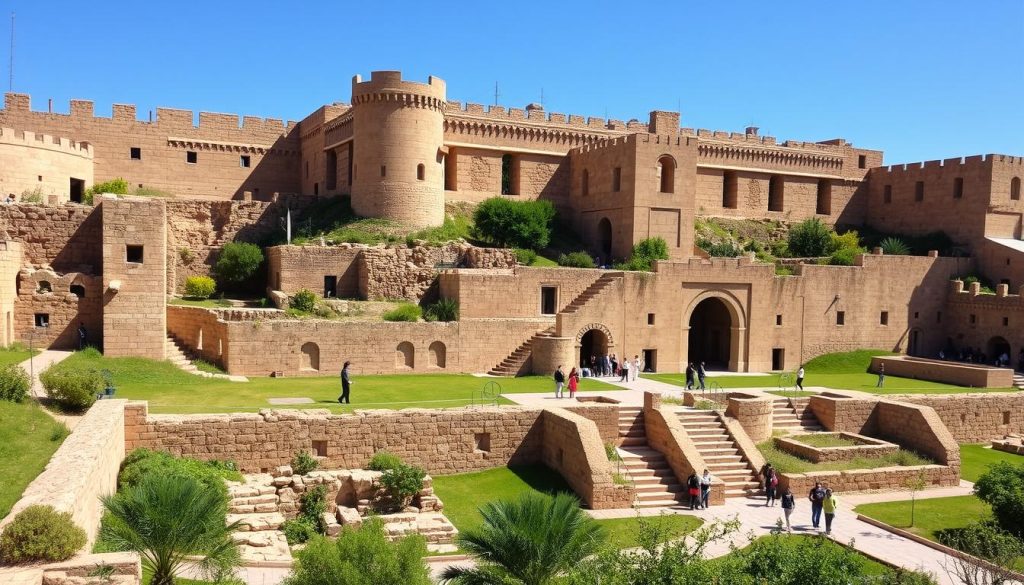
“The citadel complex of Bosra Al-Sham is a true marvel, where the grandeur of Syrian castles and the legacy of the Roman Empire converge in a captivating display of architectural prowess.”
Bosra, Syria: Best Things to Do - Top Picks
The ancient city of Bosra is in southern Syria. It’s full of cultural experiences for brave travelers. You can see Roman architecture or learn about Islamic heritage here.
Must-See Attractions
The Roman Theater is Bosra’s main attraction. It’s an amphitheater from the 2nd century AD. Its stone carvings are amazing, and you can picture the shows that happened there.
Don’t miss the Al-Omari Mosque either. It’s a beautiful mosque with a tall minaret and peaceful prayer halls.
Hidden Gems
Bosra has many hidden spots for those who love to explore. Check out the Nabataean Ruins to see what an ancient civilization left behind. Or visit the Ancient Citadel Complex for a quiet moment in history.
Local Experiences
Getting to know Bosra’s locals is key. Visit the local markets to find unique souvenirs and try delicious food. You might even catch a traditional cultural event or festival.
Bosra is a top spot for Bosra tourism, Syria sightseeing, and cultural experiences. Its history, hidden spots, and culture will leave you enchanted.
Local Culture and Cuisine
Visiting Bosra, Syria, is a chance to dive into the rich Hauran culture and enjoy the famous Syrian food. You can try traditional dishes and see local crafts. This ancient city shows the lively heritage of the area.
The Hauran region, where Bosra is, has its own food traditions. Syrian shawarma is a local favorite, with its flaky and buttery bread. Fattoush, a tasty Arabic salad, is often found on Syrian dinner plates. And muhammara, a red pepper and walnut dip, is a must-try.
Dessert fans will love the many baklava and kunafa pastries. These sweet treats are a source of pride for Syrian bakers. Kibbeh is another iconic dish, with its fried, baked, and yogurt-based forms.
| Traditional Syrian Dishes | Unique Characteristics |
|---|---|
| Syrian Shawarma | Flakier and butterier bread |
| Fattoush | A common feature on Syrian dinner tables |
| Muhammara | Intense flavor profile of red pepper and walnut dip |
| Baklava and Kunafa | Wide array of sticky-sweet pastries |
| Kibbeh | Fried, baked, and yogurt-based variations |
Bosra also lets you see the traditional crafts of the Hauran culture. You might get to watch or even make these unique, skilled items.
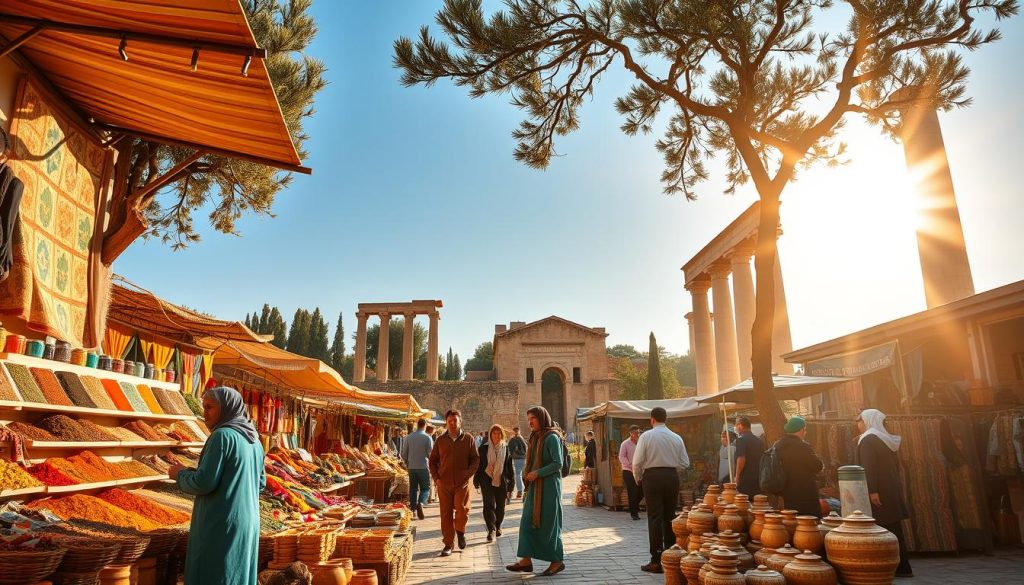
Exploring the local culture and food of Bosra is an experience you won’t forget. It lets you connect with the rich heritage of this amazing part of Syria.
Photography Spots and Viewpoints
Bosra is a treasure trove for photographers. It has ancient ruins and a rich history. Whether you’re a pro or just starting, Bosra’s beauty and heritage are perfect for capturing Syria’s past.
Best Times for Photos
The ancient Roman Theater is a top spot for photos. Visit during the golden hours, early morning or late afternoon. The soft light adds magic to your photos, showing off the theater’s details and size.
Recommended Angles
For wide views, go to the citadel complex’s high spots. These spots give you a bird’s-eye view. Try different angles to find the best shots.
Lighting Conditions
The ruins look great in the right light. Visit in the early morning or late afternoon for soft, directional light. This light creates dramatic shadows and highlights, making the Bosra photography spots stand out.
Always follow local rules and respect when taking photos in Bosra. This ensures a good and respectful Syria travel photography experience.
Practical Travel Tips
Before you head to Bosra in Syria, make sure you know the latest Syria travel advice. Look up any travel warnings and get the right visas or permits. A local guide can make your Bosra visitor experience better and help you find secret spots.
When you’re at Bosra’s ancient sites, remember the etiquette for archaeological sites. Wear comfy shoes and don’t forget sun protection. Also, respect local traditions and dress codes, especially at places like the Al-Omari Mosque.
Because of recent troubles, Bosra’s tourist facilities are limited. Pack what you need and be ready for any challenges. Exploring this historic place can be unique and rewarding.
- Check current travel advisories and obtain necessary permits before visiting Bosra.
- Hire a knowledgeable local guide to maximize your sightseeing experience.
- Wear comfortable walking shoes and bring sun protection.
- Respect local customs and dress codes, especially when visiting religious sites.
- Be prepared for limited tourist infrastructure due to recent conflicts in the region.
| Visa Type | Duration | Cost (USD) |
|---|---|---|
| 6-month (single/multiple entry) | 6 months | $131 or €100 |
| 3-month (single entry) | 3 months | $131 or €100 |
| 15-day (land borders only) | 15 days | $131 or €100 |
By following these tips, you can have a safe and unforgettable trip to Bosra, Syria.
“Bosra is a testament to the rich history and cultural heritage of Syria, a destination that captivates the senses and transports visitors to a bygone era.”
Conclusion
Bosra, an ancient city in Syria, is a treasure trove of history and culture. Despite recent conflicts, efforts are being made to save its landmarks. This offers visitors a chance to see well-preserved Roman and Islamic architecture.
Exploring Bosra takes you back in time and supports local tourism. By visiting, you help preserve Bosra’s heritage. This is crucial for Syria’s tourism, which has been hit hard in recent years.
Walking through the ancient amphitheater, Nabataean ruins, and mosques, you’ll feel Bosra’s spirit. It shows the Syrian people’s strength in keeping their culture alive, even when things are tough. Your visit will not only make your trip special but also help protect this important piece of history for the future.
